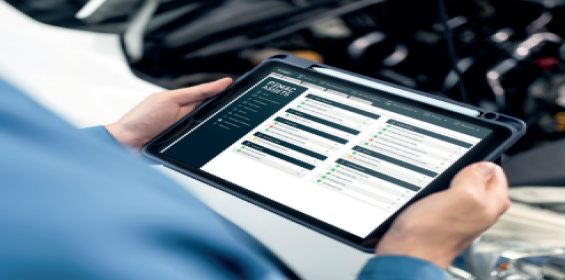Enhancing Reliability, Availability, and Maintainability (RAM) through maintenance management
Published: 18 December, 2023
Donal Bourke, PEMAC Director of Sales, delves into the reasons why good maintenance management practices within manufacturing can significantly improve RAM. Additionally, he explores how CMMS software should align with RAM principles to help organisations reach new heights of operational efficiency.
In manufacturing, the triumvirate of Reliability, Availability, and Maintainability (RAM) is crucial for ensuring the seamless operation of equipment, reducing downtime, and ultimately boosting productivity and profitability. RAM is not just a buzzword; it’s a set of essential parameters that can make or break an organisation’s success in the competitive manufacturing landscape.
RAM analysis is a well-known method of estimating the production availability of a system by assessing failure modes, frequencies, and consequences, while paying attention to the effect on production. The main objectives of RAM analysis are to increase system productivity, increase overall profit, and reduce total life equipment cycle costs, which include the costs associated with production downtime, maintenance, and operations, amongst others.
Understanding RAM in manufacturing
One of the key pillars for achieving RAM excellence is effective maintenance management. Before we dive into the impact of maintenance management on RAM, let’s briefly define each element:
Reliability: ‘Reliability’ refers to the probability that a system or equipment will perform its intended function without failure over a specified time period. In manufacturing, unreliable equipment can lead to costly breakdowns and production disruptions.
Availability: ‘Availability’ is the measure of the percentage of time that equipment is operational and ready for use. High availability ensures that production processes can run smoothly without unplanned downtime.
Maintainability: ‘Maintainability’ assesses how easily and quickly equipment can be restored to an operational state after a breakdown. Efficient maintenance processes are essential for minimising downtime.
The role of maintenance management
Maintenance management plays a pivotal role in optimising RAM in manufacturing, contributing to the seamless operation of equipment, reduced downtime, and enhanced productivity. One of the primary ways in which maintenance management achieves this is through preventative maintenance. Scheduled maintenance routines are key to improving reliability as they identify and address potential issues before they can escalate into costly breakdowns. This proactive approach significantly reduces unplanned downtime, ultimately enhancing availability and ensuring that production processes run smoothly.
In addition to preventative maintenance, predictive maintenance is critical aspect of effective RAM optimisation. By harnessing the power of data and predictive analytics, maintenance teams can foresee when equipment is likely to fail and take preventative measures. This forward-looking approach minimises the impact on reliability and availability, enabling organisations to avoid costly production disruptions.
Downtime reduction is another vital facet of maintenance management in the pursuit of RAM excellence. Efficient maintenance management aims to minimise downtime through quick and effective repairs. By improving maintainability, equipment can be swiftly brought back online, minimising production losses and preserving overall operational efficiency.
Proper asset management is fundamental to achieving RAM objectives. Well-managed assets are less likely to fail prematurely. Maintenance management systems play a crucial role in tracking the condition of assets, ensuring they receive timely maintenance, and keeping them in optimal working condition. This leads to improved reliability and availability across the board.
Lastly, data-driven decision-making is integral to the RAM optimisation process. Maintenance managers can make informed decisions by analysing historical data, performance metrics, and maintenance records. This data-driven approach leads to better resource allocation, prioritised maintenance efforts, and overall improved RAM performance.
The importance of CMMS in manufacturing
Maintenance is an essential aspect of any manufacturing business or organisation, and it is essential to ensure that equipment and machinery are operating optimally to prevent downtime and prolong their lifespan. To achieve this, many companies use maintenance management systems, such as CMMS (Computerised Maintenance Management System) software.
CMMS software is a computerised system that assists maintenance teams in managing and tracking maintenance activities, equipment inventory, and work orders. It provides an easy-to-use interface for maintenance personnel to track equipment history, schedule maintenance tasks, and create work orders. Additionally, a good CMMS software can seamlessly integrate with other business systems, such as Enterprise Resource Planning (ERP) and manufacturing execution systems (MES), to ensure the seamless flow of information across an organisation. By investing in CMMS software and implementing a robust preventative maintenance programme, manufacturing organisations can help position themselves for long-term success and growth.
RAM-centric
CMMS solutions A robust CMMS software provider should make RAM a key focus and have these principles aligned as closely as possible to its core values. It should be designed to help organisations enhance their Reliability, Availability, and Maintainability in the following ways:
Preventative Maintenance: CMMS can enable organisations to set up and manage preventative maintenance schedules efficiently. This ensures that equipment is regularly inspected and serviced, promoting reliability and availability.
Predictive Maintenance: CMMS can interface with predictive maintenance technologies, allowing users to predict equipment failures based on real-time data. This proactive approach reduces unplanned downtime and improves reliability
Downtime Tracking: CMMS can provide detailed insights into downtime events, helping organisations identify the root causes of failures and improve maintainability.
Asset Management: CMMS can offer comprehensive asset management capabilities, allowing organisations to track asset performance, maintenance history, and condition monitoring data to optimise reliability.
Business Intelligence: CMMS can leverage business intelligence and data analysis to provide actionable insights, enabling data-driven decision-making for better resource allocation and enhanced RAM.
Conclusion
In the competitive world of manufacturing, achieving, and maintaining high levels of Reliability, Availability, and Maintainability (RAM) is essential for success. Good maintenance management practices are the cornerstone of achieving RAM excellence. It is essential that a good CMMS provider recognises the significance of RAM, and that maintenance management software aligns with RAM principles.
A good RAM-centric CMMS software solution can be a powerful tool for manufacturing organisations looking to improve their preventative maintenance strategies. CMMS software provides a comprehensive solution for managing and tracking preventative maintenance tasks, enabling organisations to implement an effective preventative maintenance programme.
By leveraging CMMS, organisations can enhance the reliability of their equipment, increase its availability, and improve its maintainability. In doing so, they can reduce downtime, lower operational costs, and ultimately become more competitive in the manufacturing industry
https://www.linkedin.com/company/pemac/







